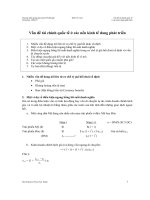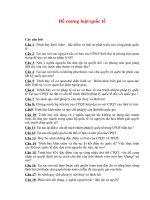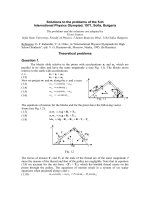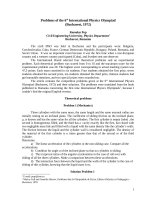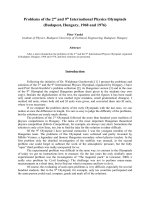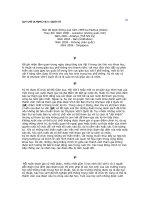Đề IPHO(vật lí quốc tế) 1971-1
Bạn đang xem bản rút gọn của tài liệu. Xem và tải ngay bản đầy đủ của tài liệu tại đây (102.29 KB, 3 trang )
V International Physics Olympiad, 1971
Sofia, Bulgaria
The problems and the solutions are adapted by
Victor Ivanov
University of Sofia, Faculty of Physics, 5 James Bourchier Blvd., 1164 Sofia, Bulgaria
Reference: O. F. Kabardin, V. A. Orlov, in “International Physics Olympiads for High School
Students”, eds. V. G. Razumovski, Moscow, Nauka, 1985. (In Russian).
Theoretical problems
Question 1.
A triangular prism of mass M is placed one side on a frictionless horizontal plane as
shown in Fig. 1. The other two sides are inclined with respect to the plane at angles α
1
and α
2
respectively. Two blocks of masses m
1
and m
2
, connected by an inextensible thread, can slide
without friction on the surface of the prism. The mass of the pulley, which supports the thread,
is negligible.
• Express the acceleration a of the blocks relative to the prism in terms of the acceleration
a
0
of the prism.
• Find the acceleration a
0
of the prism in terms of quantities given and the acceleration g
due to gravity.
• At what ratio m
1
/m
2
the prism will be in equilibrium?
Fig. 1
Question 2.
A vertical glass tube of cross section S = 1.0 cm
2
contains unknown amount of hydrogen.
The upper end of the tube is closed. The other end is opened and is immersed in a pan filled
with mercury. The tube and the pan are placed in a sealed chamber containing air at temperature
T
0
= 273 K and pressure P
0
= 1.334×10
5
Pa. Under these conditions the height of mercury
column in the tube above the mercury level in the pan is h
0
= 0.70 m.
One of the walls of the chamber is a piston, which expands the air isothermally to a
pressure of P
1
= 8.00×10
4
Pa. As a result the height of the mercury column in the tube decreases
to h
1
= 0.40 m. Then the chamber is heated up at a constant volume to some temperature T
2
until
the mercury column rises to h
2
= 0.50 m. Finally, the air in the chamber is expanded at constant
pressure and the mercury level in the tube settles at h
3
= 0.45 m above the mercury level in the
pan.
α
1
α
2
m
1
m
2
Provided that the system is in mechanical and thermal equilibrium during all the
processes calculate the mass m of the hydrogen, the intermediate temperature T
2
, and the
pressure P in the final state.
The density of mercury at temperature T
0
is ρ
0
= 1.36×10
4
kg/m
3
, the coefficient of
expansion for mercury β = 1.84×10
–4
K
–1
, and the gas constant R = 8.314 J/(mol×K). The
thermal expansion of the glass tube and the variations of the mercury level in the pan are not
considered.
Hint. If ∆T is the interval of temperature variations of the system then β∆T = x << 1 In
that case you can use the approximation:
x
x
−≈
+
1
1
1
.
Question 3.
Four batteries of EMF E
1
= 4 V, E
2
= 8 V, E
3
= 12 V, and E
4
= 16 V, four capacitors with
the same capacitance C
1
= C
2
= C
3
= C
4
= 1 µF, and four equivalent resistors are connected in
the circuit shown in Fig. 3. The internal resistance of the batteries is negligible.
• Calculate the total energy W accumulated on the capacitors when a steady state of the
system is established.
• The points H and B are short connected. Find the charge on the capacitor C
2
in the new
steady state.
Fig. 3
Question 4.
A spherical aquarium, filled with water, is placed in front of a flat vertical mirror. The
radius of the aquarium is R, and the distance between its center and the mirror is 3R. A small
fish, which is initially at the point nearest to the mirror, starts to move with velocity v along the
wall. An observer looks at the fish from a very large distance along a horizontal line passing
trough the center of the aquarium.
What is the relative velocity v
rel
at which the two images of the fish seen by the observer
will move apart? Express your answer in terms of v. Assume that:
• The wall of the aquarium is made of a very thin glass.
• The index of refraction of water is n = 4/3.
E
1
E
2
E
3
E
4
C
1
C
2
C
3
C
4
A
B
C
D
E
F
GH
Experimental Problem
Apparatus: dc source, ammeter, voltmeter, rheostat (coil of high resistance wire with sliding
contact), and connecting wires.
Problem: Construct appropriate circuit and establish the dependence of the electric power P
dissipated in the rheostat as a function of the current I supplied by the dc source.
1. Make a plot of P versus I.
2. Find the internal resistance of the dc source.
3. Determine the electromotive force E of the source.
4. Make a graph of the electric power P versus resistance R of the rheostat.
5. Make a graph of the total power P
tot
dissipated in the circuit as a function of R.
6. Make a graph of the efficiency η of the dc source versus R.
